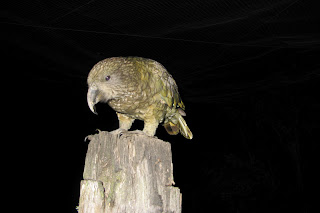During an education program geared for children 2nd grade and under, called Wings for Tots, I ask the kids, “What makes birds different from other creatures?” Their first answer is always, “they can fly!”
But of course, as we know, not all birds can fly! And there may be more of them than you realize. There are about forty species of flightless birds in existence today. However, with there being around 10,000 bird species in the world, 0.004 % of those being flightless, that makes them weird! The most well-known are the ostrich and penguins. In this episode of Really Weird Birds, I am going to discuss a not so well-known species of flightless bird, the kakapo, native to the forests of New Zealand.
Kakapos are nocturnal and are also called the owl parrot.
The kakapo has several characteristics that make it unique. First, it is the world’s only flightless parrot. The country of New Zealand has the largest number of flightless birds in the world. Before settlers arrived and introduced predators like dogs, cats and ferrets, there were no large land predators on these isolated islands. However, when these invasive predators and human hunters were introduced, populations of many flightless bird species declined rapidly. Some became extinct. Getting close to a kakapo will reveal a very strong musty smell. This odor also aided in their rapid decline by leading dogs and cats right to them. The kakapo is also one of the rarest parrots in the world. According to the Kakapo Recovery Program, in 1995 there were only fifty known kakapo surviving. Today, there are just under 150 individuals in the world.
Kakapo photographed at Willowbank Wildlfe Reserve, Christchurch, NZ by Art Schroer
The kakapo is also the world’s heaviest parrot. Unlike other land birds, they can accumulate large amounts of body fat to store energy and can weigh up to nine pounds. They are nocturnal in order to avoid diurnal birds of prey, once their main predator. The beak of the Kakapo is built for grinding food finely. For this reason, the Kakapo has a very small gizzard (a bird’s stomach) compared to other birds of its size. They are strict vegetarians who will forage on the forest floor or use their feet and beak to climb up trees to forage. In order to get down, they will use their wings to “parachute” to the ground. They cannot fly because they lack a pronounced keel bone (the bone in the center of a bird’s chest) which anchors large flight muscles. Parrots are well known for their bright standout colors. However the kakapo is the opposite. Their feathers have extreme camouflage, blending into the ferns and mosses of the New Zealand forest floor.
Kakapos camouflage extremely well in New Zealand’s forest.
The kakapo is the only parrot to have a polygymous lek breeding system. In the breeding season, male kakapos take to prominent ridges, rocks or hilltops with low-growing vegetation and begin a courtship competition for female attention. They inflate a thoracic air sac, like a balloon, and emit a low 'sonic' boom which, in mountainous terrain, can be heard up to 3 miles away. They are announcing to females that they are ready to mate. Females are the sole caretakers of the chicks.
Kakapos are one of our world’s unique birds that are on the brink of extinction because of human settlement. They are the only flightless parrot, they are the heaviest parrot, males inflate like balloons and boom to attract mates, they are nocturnal, they give off a strong musty odor, they have extreme camouflage, and they are the only parrot to have a lek breeding system. If you want to help endangered birds, part of the World Bird Sanctuary’s mission is to secure the future of threatened bird species in their natural environments. You can help us fulfill that mission by visiting us and spreading what you’ve learned, becoming a member or friend, or adopting-a-bird and feeding that bird for a year!
Submitted by Sara Oliver, Naturalist.







No comments:
Post a Comment